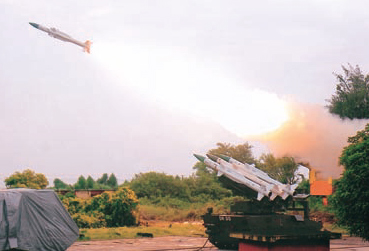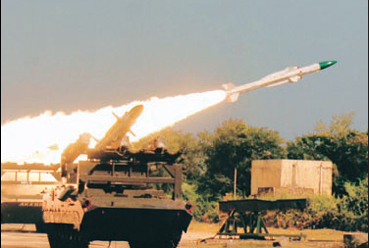|
New Delhi. The Indian Air Force (IAF)
has finally decided to home on the indigenous
Akash Surface-to-Air Missile (SAM) to protect
its airbases.
Chief Controller in the Defence Research and
Development Organisation (DRDO) Dr Prahlada (uses
one name) told India Strategic in
an interview that the all-weather, multi-target
missile was accepted by the IAF recently after
nine successful field trials, including a ripple
fire in the electronic clutter. Further tests
were likely but more for practice and building
user awareness and confidence.
 Initially,
the air force would take two squadrons, and later,
it should have another five squadrons. Initially,
the air force would take two squadrons, and later,
it should have another five squadrons.
He said that the Indian Army had also accepted
the missile as effective but some modifications
in their transport mode were being worked out
to its specifications. The IAF units would be
on Tatra trucks, built by the public sector BEML,
while the army fire units would on T-72 tank chassis.
Akash, meaning sky in Hindi, can be ferried by
air, road or rail.
Chief of Air Staff Air Chief Marshal F H Major
also told India Strategic that
IAF would be inducting the Akash missile as area
defence weapons as part of a multi-layered approach.
Akash has an effective range of 25 km, extendable
to 30 km, but as hostile aircraft fire from long
range these days, a layered approach is essential
to neutralize them as far away as possible.
Akash is an all -weather, 24 x 7, SAM capable
of remote or autonomous management with advanced
Electronic Counter Counter Meassures (ECCM) capability.
In the recent trials, conducted before IAF and
Army observers, the experimental clutter created
to stray it off its course, had no impact on the
course of the missile.
IAF has already asked short-listed a version
of the Israeli Barak medium range (MR SAM) missile
which would be capable of precision-engaging hostile
aircraft till a distance of 70 km. The Indian
government has sanctioned US$ 2.5 billion for
the indigenous production of this system in collaboration
between the Israel Aircraft Industries (IAI) and
DRDO.
IAF has also asked for the quick reaction Spyder
missile, which is also from Israel, as a mid-range
interceptor.
All these missiles would be capable of engaging
hostile low-level aircraft and missiles with precision.
The proposal however is stuck due to certain
procedural problems, although the same missile
is also cleared for use by the Indian Navy in
a slightly different version.
New Generation technologies are being used both
in the Akash and Barak, thanks to the collaboration
offers now coming from worldwide.
Dr Prahlada said that there was a time when DRDO
had to fabricate even its nuts and bolts.
“Today, 14 countries including the US, Russia,
Germany, France, UK and Israel had offered the
best of their technologies, some of which we really
need as that cuts the development time.”
A distinguished and respected scientist who is
also the interface between the DRDO and the Indian
armed forces for induction of their needs, Dr
Prahlada said that Commercially Available Off
the Shelf (COTS) components were the order of
the day, and now that technology denial regimes
against India were largely going or gone, their
acquisition would help save even money as these
should be cheaper.
 In
fact, commercial availability of technologies
and components now was one of the main reasons
for scrapping the indigenous Integrated Guided
Missile Development Programme (IGMDP). In
fact, commercial availability of technologies
and components now was one of the main reasons
for scrapping the indigenous Integrated Guided
Missile Development Programme (IGMDP).
The late Prime Minister Indira Gandhi encouraged
development of indigenous missiles, and a coordinated
plan was started in 1983 under Mr A P J Abdul
Kalam as the Chairman of the Programme Management
Board of IGDMP. A space scientist from the Indian
Space Research Organisation (ISRO), he was well
aware of the propulsion and homing of projectiles.
He was not only one of the founding fathers of
the Indian missile programme but also became the
President of India later.
Dr Kalam also emphasized the importance of stealth,
super computers and precision and that direction
is well integrated into the Indian missile programme
now.
Dr Prahlada declined to mention what components
India would specifically acquire from abroad,
pointing out that every little thing was important.
“A missile has to have steady, designated
course and must acquire the target for the latter’s
destruction.
Propulsion and homing, both are equally important
for precision engagement.”
Indian missiles use standard solid fuel propellants
with variations as required. They fire quickly
and ensure that a projectile or rocket is on a
steady, set course. Akash uses ramjet - rocket
propulsion for the sustainer phase, while for
target acquisition, it uses the Bharat Electronics
Ltd. (BEL)-made Rajendra phased array radar.
 The
hi-tech precision radar is the heart of the missile
system, which uses sophisticated computers and
secure, indigenous software for connectivity and
precision engagement of the target to kill it. The
hi-tech precision radar is the heart of the missile
system, which uses sophisticated computers and
secure, indigenous software for connectivity and
precision engagement of the target to kill it.
As for the missile’s production, Dr Prahlada
said that 90 per cent of the missile components
would be made by private companies, and “we
are doing every thing to encourage their involvement.”
The integration of the system though would be
carried out by the state-run Bharat Dynamics Ltd.,
(BDL).
Nearly a dozen private Indian companies have
been assigned production of missile parts, and
it should take a couple of years to formally induct
the required numbers of squadrons.
Dr Prahlada said that the main responsibility
of DRDO was to develop a system. As the designs
are modular, the user and manufacturers would
be able to stretch and expand the capabilities,
upgrading as newer technologies are available
during user trials.
He described Akash as a “multidirectional,
multi-target” system with a kill probability
of 88 per cent with a single shot, and 95 per
cent with twin- fire. The missile can neutralize
high performance air targets like tactical strike
aircraft, UAVs, bombers, high altitude reconnaissance
aircraft and armed helicopters.
Akash is made of: Integral Ramjet Propulsion,
Command Guidance Unit, Digital Autopilot, Onboard
Power Supply, Switchable Guidance Antenna System,
System Arming and Detonation Mechanism and a 55-kilo
Warhead with prefabricated tungsten alloy cubes.
The missile is 5.8 mtres in length with a diameter
of 350mm and a wing span of 1105 mm. It weights
720 kg and flies at twice the speed of sound,
or Mach 2.
|